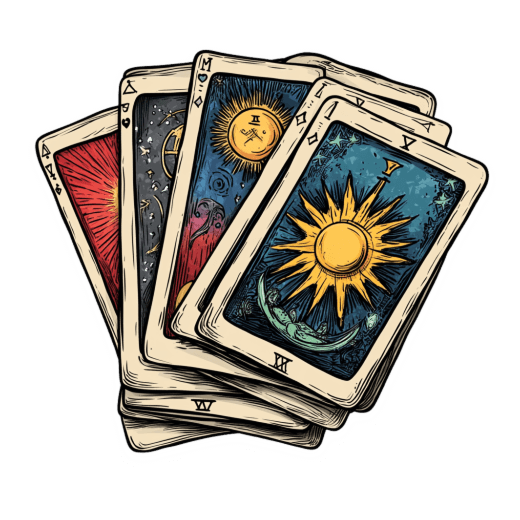How to Use Tarot for Grief and Healing


Table of Contents
Did you know that nearly 2.5 million Americans die each year, leaving behind an average of five grieving loved ones per death? That’s over 12 million people annually navigating the turbulent waters of grief. I’ve been there myself, and I know firsthand how overwhelming that journey can be.
When my sister passed away unexpectedly in 1997, I found myself completely adrift. Traditional counseling helped, but something was missing—a deeper connection to the process, a way to make meaning from the seemingly senseless pain. That’s when I turned to my tarot cards, not for prediction, but for reflection.
The symbolic language of tarot offered me something my grief support group couldn’t—a personal, spiritual framework for understanding my emotions and honoring my sister’s memory. The cards became mirrors reflecting my inner landscape, helping me recognize feelings I couldn’t yet verbalize.
Since that time, I’ve guided thousands of clients through their own grief journeys using tarot as a complementary healing tool. In my experience, the cards provide a unique bridge between our conscious mind and deeper emotions, offering insights that might otherwise remain hidden.
In this guide, I’ll share practical approaches to using tarot during times of loss—whether you’re a complete beginner or an experienced reader. We’ll explore specific spreads, key cards, and meaningful rituals that can support your healing process. I’ll also discuss when professional support might be beneficial and how tarot can work alongside traditional grief counseling.
Grief isn’t linear, and it doesn’t follow a tidy roadmap. Some days feel impossibly heavy, while others bring unexpected moments of peace. The beauty of tarot for grief work is that it meets you exactly where you are on any given day, providing what you need most in that moment.
I want to emphasize that tarot doesn’t replace professional mental health support during bereavement. Rather, it offers a complementary approach that honors the spiritual and emotional dimensions of loss. The cards won’t “fix” your grief—nothing can or should—but they can help illuminate your path forward, one step at a time.
Let’s begin this journey together, with gentleness and respect for your unique experience of loss.
Understanding How Tarot Supports the Grief Journey
The day I pulled The Moon card after my sister’s funeral remains vivid in my memory. There I sat, tears streaming down my face, as that haunting image of uncertainty and hidden depths perfectly captured my emotional state. I couldn’t articulate my feelings to friends or family, but somehow, that card spoke what my heart couldn’t say.
This is perhaps the most profound gift tarot offers during grief—a visual language for the often inexpressible experience of loss. When words fail us, symbols speak. According to Dr. Melanie Greenberg, clinical psychologist and author, “Symbolic representation allows access to emotions that may be too overwhelming to process directly” (Greenberg, 2019, The Stress-Proof Brain).
Tarot creates psychological distance that can make exploring painful emotions more manageable. Rather than directly confronting the raw wound of grief, we can examine it through the lens of archetypes and storytelling. The Death card becomes not just about our literal loss, but about transformation and necessary endings. The Five of Cups invites us to acknowledge spilled cups while also noticing those still standing.
I’ve noticed in my practice that clients often experience what psychologists call “emotional catharsis” during grief-focused readings. One gentleman I worked with had maintained stoic composure throughout his wife’s funeral and aftermath. During our session, The Tower appeared, depicting destruction and sudden change. “That’s exactly how it felt,” he whispered, finally allowing himself to cry for the first time since her passing.
The structure of tarot also provides containment for overwhelming emotions. By focusing on specific questions or spreads, the vastness of grief becomes more approachable. We transform amorphous pain into discrete areas we can address one card at a time.
What surprises many beginners is how tarot encourages active participation in the healing process. Unlike passive consumption of comfort, tarot reading requires engagement—shuffling cards, considering meanings, making connections. This gentle activation helps counteract the powerlessness often experienced during grief.
I’ve made mistakes in my approach over the years. Initially, I was too quick to emphasize “moving on” with clients, highlighting cards that suggested future happiness. I’ve learned that healing isn’t about rushing forward but about honoring the present moment, however painful. Sometimes, the most healing reading simply acknowledges the legitimacy of someone’s suffering without trying to fix it.
The non-linear nature of tarot also mirrors the non-linear nature of grief itself. Some days bring The Star’s hope, others The Moon’s confusion. The cards normalize this emotional oscillation, reminding us that healing rarely follows a straight path.
Powerful Tarot Spreads Designed Specifically for Grief Work
When I first started using tarot for my personal grief journey, I made the mistake of using complicated spreads that left me more confused than comforted. Through years of working with bereaved clients, I’ve discovered that simplicity often proves most powerful when emotions run high.
For those in acute grief—those raw, early days of loss—I recommend beginning with what I call the “Emotional Support” three-card spread:
- What do I need to acknowledge about my feelings right now?
- What comfort or wisdom is available to me today?
- How can I best care for myself in this moment?
This straightforward layout provides immediate guidance without overwhelming a grieving mind. One client, a woman who’d lost her mother just weeks earlier, pulled the Five of Cups, Temperance, and The Empress for these positions. “It gave me permission to grieve,” she later told me, “while also reminding me that balance and self-nurturing were still possible—something I desperately needed to hear.”
As you move deeper into your grief journey, you might find value in more comprehensive layouts. The “Grief Processing” spread uses seven cards arranged in a crescent shape:
- The nature of my loss
- What I’m finding most difficult to accept
- Emotions I may be suppressing
- A strength I can draw upon
- Something to release
- A way to honor what/who I’ve lost
- A gentle step forward
I find this spread particularly helpful when clients feel stuck in their grief. The progression from acknowledging difficulty to identifying a small step forward often provides both validation and gentle momentum.
For those seeking connection with departed loved ones, the “Beyond the Veil” spread can offer profound comfort:
- A message from my loved one
- What they want me to remember
- How they would want me to heal
- How I can honor their legacy
I approach this spread with particular care and ethical awareness. Rather than claiming literal communication with the deceased, I frame these cards as a way of connecting with your own intuitive understanding of what your loved one might wish for you.
When working with complicated grief—grief that’s become entangled with trauma or remained intensely painful over extended periods—I sometimes suggest the “Untangling” spread:
- The core of my grief
- What’s complicating my healing
- A hidden factor I’ve been overlooking
- A resource I haven’t fully utilized
- A new perspective that might help
These spreads aren’t rigid formulas but flexible frameworks. I encourage you to modify positions based on your specific needs or to create entirely personal spreads that resonate with your unique situation. The most effective spread is one that feels right to you.
Key Tarot Cards That Facilitate Healing After Loss
In my four decades of tarot practice, I’ve observed certain cards consistently emerge as powerful allies during grief work. Understanding these cards more deeply can enhance your healing journey, whether you’re reading for yourself or others experiencing loss.
The Death card often appears in readings for the bereaved, sometimes causing initial alarm. Despite its intimidating imagery, this card rarely predicts literal death when it appears in a reading. Rather, it speaks to transformation, release, and the natural cycles of endings and beginnings. When Marisol, a grief client, pulled this card a year after losing her partner, she initially recoiled. Through our discussion, she came to see it represented her own identity transformation—she was shedding her self-concept as one half of a couple and beginning to emerge as a whole person in her own right.
The Tower frequently appears during readings about sudden, unexpected losses. Its imagery of lightning striking a structure, causing collapse, perfectly captures the way grief can shatter our assumptions about life’s predictability and safety. I’ve found acknowledging this demolition, rather than rushing to rebuild, creates space for authentic healing. According to grief researcher Dr. Robert Neimeyer, “Meaning reconstruction in the wake of loss is the central process in grieving” (Neimeyer, 2001, Meaning Reconstruction and the Experience of Loss).
For comfort during dark times, The Star and The Sun offer particularly nurturing energies. The Star’s quiet hope—a woman kneeling by water under night sky—speaks to finding small moments of peace amid suffering. The Sun’s more exuberant joy reminds us that even in grief, moments of warmth and happiness can eventually return without diminishing our love for those we’ve lost.
The Hermit holds special significance for those feeling isolated in their grief. Its lantern illuminating a solitary path validates the inherently personal nature of loss while suggesting that our individual journey might eventually light the way for others. I’ve watched clients’ relationship with this card evolve from resentment of their aloneness to appreciation for the wisdom found in introspection.
For self-care guidance, Temperance and The Empress offer nurturing wisdom. Temperance, with its imagery of balance and flow, reminds grievers to be gentle with themselves when emotions fluctuate wildly—a normal part of healing. The Empress encourages physical and emotional self-nurturing at times when basic self-care often falls away.
The Five of Cups deserves special mention for its profound depiction of grief itself—a figure mourning three spilled cups while two remain standing behind them. This card compassionately acknowledges loss while gently suggesting that not everything is lost, even when it feels that way.
I once made the mistake of avoiding these “difficult” cards when reading for the bereaved, focusing only on encouraging cards. I’ve learned this dishonors the reality of grief. The most healing readings acknowledge the full spectrum of the experience, including its darkest moments, while still holding space for eventual healing.
Creating Sacred Space for Grief Tarot Rituals
The physical environment for grief tarot work matters more than you might think. I learned this lesson the hard way when I first began using tarot after my sister’s death. Attempting readings in my busy kitchen, surrounded by daily life’s distractions, left me feeling disconnected and frustrated. The cards seemed to offer only shallow insights.
Everything changed when I created a dedicated corner in my home—a small table with a cloth, a candle, and my sister’s photograph. The quality of my readings transformed immediately. The space itself became a container for my grief, a visual reminder that I was entering sacred territory.
You needn’t create anything elaborate. Even apartment dwellers with limited space can designate a drawer that holds grief tarot materials or a special cloth that, when spread, transforms any surface into a grief work area. The physical act of setting up this space becomes a ritual in itself, a way of telling your mind and heart: “I am making room for this grief. I am giving it attention and respect.”
Consider incorporating meaningful objects—photographs, inherited items, natural elements that symbolize your loved one. One widow I worked with always placed her husband’s wedding ring beside her tarot deck. Another client uses a special candle in her son’s favorite color. These touchstones create a sensory bridge between worlds.
Before beginning your reading, take time to prepare mentally. I recommend a simple grounding meditation: close your eyes, take three deep breaths, and visualize roots extending from your body into the earth. This helps stabilize your energy when emotions run high. As tarot researcher Mary K. Greer notes, “Emotional flooding can interfere with our ability to receive intuitive information clearly” (Greer, 2017, Tarot for Your Self).
I’ve found certain environmental elements enhance grief tarot work. Natural light, if possible, brings gentle illumination. Fresh air—even just a cracked window—helps energy flow. Soft, instrumental music can fill uncomfortable silence without distracting from your process. Some clients prefer complete quiet, and that’s perfectly valid too.
The timing of grief readings also deserves consideration. I’ve made the mistake of attempting deep grief work when exhausted or rushed, with predictably poor results. Honor your energy levels. Morning readings often access different insights than evening sessions. Neither is better—just different.
Journaling after grief tarot sessions proves invaluable. I’ve kept every journal entry from my own grief journey, and reviewing them years later revealed patterns and progress I couldn’t see in the moment. Your future self will thank you for documenting this path. Don’t worry about perfect prose—raw, honest reflections serve you best.
One of my most profound learnings has been the power of closing rituals. Early in my practice, I’d end grief sessions abruptly, leaving clients emotionally open and vulnerable. Now I recognize the importance of gentle transition back to everyday consciousness. Simple actions—blowing out a candle, covering your cards, speaking words of gratitude—signal completion and help contain powerful emotions raised during your reading.
Professional Support: When to Seek a Tarot Reader for Grief
While personal tarot practice offers tremendous healing potential, certain situations benefit from professional guidance. I’ve been on both sides of this equation—seeking readers during my own darkest grief and serving clients through theirs—giving me perspective on when outside support proves most valuable.
Consider consulting a professional reader when grief feels completely overwhelming. In those early, raw stages of loss, even simple spreads can seem insurmountable. A compassionate reader provides both tarot expertise and emotional containment, holding space for your experience without becoming overwhelmed themselves. As grief counselor Dr. Alan Wolfelt observes, “Sometimes we need someone else to walk beside us before we can walk alone” (Wolfelt, 2020, Understanding Your Grief).
Professional guidance also helps when you find yourself interpreting every card through grief’s distorting lens. I recall pulling The Sun repeatedly during my bereavement and seeing only what I was missing rather than potential joy ahead. My own reader gently expanded my perspective, helping me recognize hope I couldn’t yet access independently.
When selecting a reader for grief work, look beyond general tarot skills. Specific qualities matter tremendously in this sensitive context. Seek someone with demonstrated empathy and emotional intelligence. Avoid readers who promise to “contact” deceased loved ones or who make grandiose claims about fixing your grief.
A grief-informed tarot reader should demonstrate patience with your process, never rushing you toward “positive” interpretations or bypassing painful emotions. They should maintain appropriate boundaries while still offering genuine compassion. Their approach should emphasize empowerment rather than dependency.
I suggest interviewing potential readers before booking grief-focused sessions. Ask about their experience with bereavement work, their philosophical approach to loss, and how they handle emotionally intense sessions. A qualified professional welcomes these questions.
Watch for red flags: readers who seem uncomfortable with emotional expression, who speak mostly about themselves, who minimize your loss (“everything happens for a reason”), or who can’t articulate clear ethical boundaries should be avoided.
Timing matters significantly when seeking professional grief readings. The day after a funeral likely isn’t optimal—emotions remain too raw, and integration capacity too limited. However, waiting for grief to “pass” before seeking support defeats the purpose. I generally suggest waiting at least two weeks after an acute loss before engaging tarot, either personally or professionally.
Consider professional support particularly valuable at grief anniversaries—these temporal landmarks often trigger renewed intensity. I schedule sessions with my own reader near my sister’s birthday and death anniversary, finding outside perspective especially helpful during these vulnerable periods.
Remember that professional readings complement but don’t replace mental health support. I’ve made the mistake of relying solely on spiritual tools during grief, overlooking my need for therapy. The most comprehensive healing comes from integrating multiple supportive approaches—perhaps therapy for cognitive processing, support groups for validation, and tarot for spiritual and intuitive dimensions of grief.
Integrating Tarot with Traditional Grief Counseling
I stumbled into integrating tarot with traditional therapy quite by accident. During a particularly difficult grief therapy session following my sister’s death, I mentioned to my counselor that certain tarot cards kept appearing in my personal readings. Rather than dismissing this as irrelevant, my therapist—though unfamiliar with tarot—asked thoughtful questions about what these symbols meant to me personally.
That conversation became a turning point in my healing, demonstrating how powerfully these approaches can complement each other when combined with intention. While not all mental health professionals will be open to discussing tarot, many therapists now recognize the value of clients’ spiritual practices in the healing journey.
Research supports this integration. A 2018 study published in the Journal of Counseling Psychology found that incorporating clients’ spiritual frameworks into traditional therapy significantly improved outcomes for those dealing with loss (Martinez & Anderson, 2018). As noted grief expert William Worden explains, “Effective grief work engages both cognitive understanding and emotional processing” (Worden, 2018, Grief Counseling and Grief Therapy).
If you’re working with a therapist, consider how tarot insights might enrich your sessions. You needn’t bring physical cards (though some therapists welcome this). Simply sharing meaningful symbols or patterns you’ve noticed in your readings can provide rich material for exploration. One client reported that discussing The Hanged Man’s appearance in her personal readings helped her therapist understand her sense of suspended animation during grief.
For those without access to formal counseling, online grief support groups can serve as venues for integrating tarot insights with peer support. I facilitate a monthly virtual group where bereaved individuals share how personal tarot practice informs their grieving process. The cross-pollination of ideas often yields profound breakthroughs.
Between therapy sessions, tarot provides a structure for continued emotional processing. I suggest maintaining a therapy journal separate from your regular tarot journal, specifically for insights that bridge these modalities. Note cards or themes that seem particularly relevant to recent therapy discussions.
Some therapists express concern that tarot might promote magical thinking or denial during grief. In my experience, the opposite proves true when cards are approached reflectively rather than predictively. Tarot’s rich symbolic language actually helps grievers engage more fully with reality by providing metaphors that make painful truths more approachable.
I’ve found certain therapeutic modalities particularly compatible with tarot work. Narrative therapy, which helps clients reauthor their stories, pairs beautifully with tarot’s storytelling nature. Jungian approaches, with their emphasis on archetypes and the collective unconscious, naturally complement tarot’s symbolic framework.
The key to successful integration lies in maintaining clear boundaries between modalities. Tarot readers should never position themselves as therapists (unless separately qualified), and therapy should remain the primary venue for addressing clinical concerns like complicated grief or suicidal ideation.
When thoughtfully combined, these approaches offer something greater than either alone—therapy provides structure, clinical expertise, and cognitive reframing, while tarot offers intuitive wisdom, spiritual dimension, and symbolic language for experiences that transcend words.
Moving Forward with Tarot as Your Guide
The journey through grief never follows a straight path. Like the Fool card stepping off a cliff into the unknown, we navigate this terrain without a clear map, often feeling as though we’re walking blindfolded through unfamiliar territory. Throughout my four decades working with tarot, I’ve witnessed countless individuals find their way forward using these ancient symbols as guideposts during their darkest hours.
The cards don’t erase our pain—nothing can or should. Grief is the price we pay for love, a natural response to significant loss. What tarot offers instead is context, perspective, and a symbolic language for experiences that often defy ordinary words. Whether used alone in quiet reflection or as part of broader therapeutic support, these cards create space for both honoring what we’ve lost and gradually reweaving the torn fabric of our lives.
I still remember the moment, years into my grief journey, when I pulled the Six of Swords during a reading about my sister’s passing. That image—of figures in a boat moving from turbulent waters toward calmer shores—captured exactly where I found myself. Not “over” my grief, not “moved on” (phrases I’ve come to dislike), but navigating differently. The pain had transformed from a drowning tide into something I could carry while still moving forward.
If you take only one insight from this guide, let it be this: grief deserves patience. In our quick-fix culture, we’re often expected to resolve loss efficiently and return to “normal” functioning. The wisdom of tarot teaches us that real healing follows natural cycles—like the Wheel of Fortune turning in its own time, like Death yielding eventually to new growth.
As you work with these practices, be gentle with yourself. Some days you’ll feel drawn to deep, intensive card work; other days, simply shuffling your deck while breathing mindfully may be enough. Trust your intuition about what serves your healing in each moment.
Remember that while grief may change shape over time, the connection to those we’ve lost endures. Many clients report that tarot helps them maintain these bonds in meaningful ways, transforming painful absence into continued relationship. As grief expert David Kessler writes, “The reality is that you will grieve forever. You will not ‘get over’ the loss of a loved one; you will learn to live with it” (Kessler, 2019, Finding Meaning).
May the cards illuminate your unique path through grief, one shuffle at a time.
Frequently Asked Questions
Is it disrespectful to use tarot when grieving a loved one?
Not at all. Throughout history, humans have used symbolic tools to process grief. While some religious traditions have specific prohibitions against divination, tarot used for self-reflection and emotional processing is simply another way to explore your grief journey. The key lies in your intention—approaching cards with respect rather than as entertainment or attempts to “prove” afterlife communication.
How soon after a loss is it appropriate to use tarot?
This varies considerably between individuals. In my experience, the immediate aftermath of loss (first 1-2 weeks) may not be the most productive time for tarot work, as shock and numbness can inhibit integration of insights. I generally suggest waiting until you’ve moved past the initial crisis phase. That said, gentle, supportive spreads might provide comfort even in early grief if approached with care.
Can tarot help with complicated grief that hasn’t resolved over time?
Tarot can provide valuable insights for complicated grief, particularly around identifying stuck points or unacknowledged aspects of your experience. However, persistent complicated grief (grief that remains intensely painful and debilitating after extended periods) generally requires professional mental health support. Tarot works best as a complement to therapy in these situations, not a replacement.
Will tarot tell me if my loved one is okay or help me communicate with them?
This question reflects a common misunderstanding about tarot’s function. While cards might provide comfort and insight about your relationship with the deceased, ethical tarot practice doesn’t claim to channel messages from the dead or provide “proof” about afterlife conditions. Cards that seem to speak in the voice of your loved one are better understood as accessing your own intuitive knowledge of what they might say.
I pulled “negative” cards during my grief reading. Is this a bad sign?
Cards like The Tower, Ten of Swords, or Five of Cups aren’t inherently negative—they’re honest about difficult experiences. Drawing these cards during grief work often simply validates the reality of your pain rather than predicting negative outcomes. In fact, seeing your genuine emotions reflected in the cards can be deeply validating and healing.
Do I need to be experienced with tarot to use it for grief work?
Not necessarily. While deeper tarot knowledge enhances the experience, even beginners can benefit from simple spreads using just the card imagery as a starting point for reflection. Consider starting with just the Major Arcana cards if you’re new to tarot, as these contain the most universal archetypes and are often easier for beginners to interpret intuitively.
How do I explain my tarot practice to others who might not understand?
You’re not obligated to share your grief tarot practice with anyone. If you choose to, it can help to frame it as a reflective tool similar to journaling rather than “fortune telling.” You might explain that the symbolic images help you process emotions and gain perspective on your experience. Be prepared that some people may not understand, and that’s okay—your grief journey is personal.






